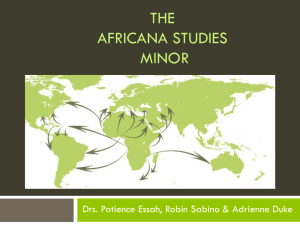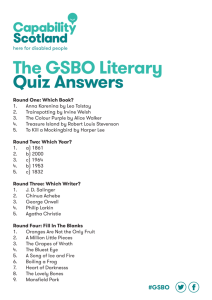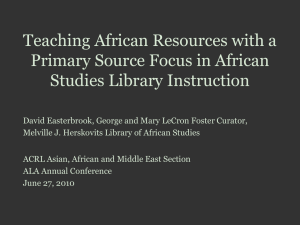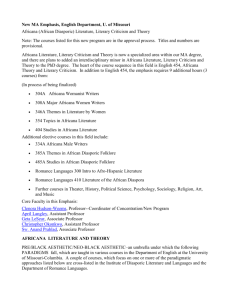View/Open
advertisement
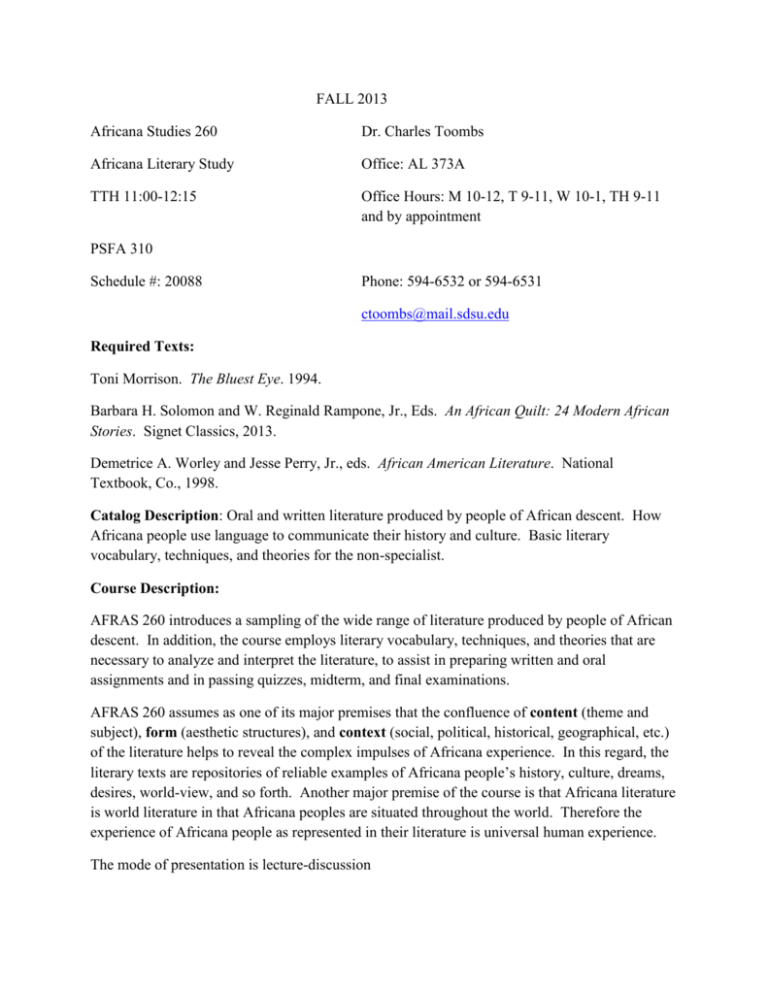
FALL 2013 Africana Studies 260 Dr. Charles Toombs Africana Literary Study Office: AL 373A TTH 11:00-12:15 Office Hours: M 10-12, T 9-11, W 10-1, TH 9-11 and by appointment PSFA 310 Schedule #: 20088 Phone: 594-6532 or 594-6531 ctoombs@mail.sdsu.edu Required Texts: Toni Morrison. The Bluest Eye. 1994. Barbara H. Solomon and W. Reginald Rampone, Jr., Eds. An African Quilt: 24 Modern African Stories. Signet Classics, 2013. Demetrice A. Worley and Jesse Perry, Jr., eds. African American Literature. National Textbook, Co., 1998. Catalog Description: Oral and written literature produced by people of African descent. How Africana people use language to communicate their history and culture. Basic literary vocabulary, techniques, and theories for the non-specialist. Course Description: AFRAS 260 introduces a sampling of the wide range of literature produced by people of African descent. In addition, the course employs literary vocabulary, techniques, and theories that are necessary to analyze and interpret the literature, to assist in preparing written and oral assignments and in passing quizzes, midterm, and final examinations. AFRAS 260 assumes as one of its major premises that the confluence of content (theme and subject), form (aesthetic structures), and context (social, political, historical, geographical, etc.) of the literature helps to reveal the complex impulses of Africana experience. In this regard, the literary texts are repositories of reliable examples of Africana people’s history, culture, dreams, desires, world-view, and so forth. Another major premise of the course is that Africana literature is world literature in that Africana peoples are situated throughout the world. Therefore the experience of Africana people as represented in their literature is universal human experience. The mode of presentation is lecture-discussion This course is one of four Foundations courses that you will take in the area of Humanities and Fine Arts. Upon completing this area of Foundations, you will be able to: 1) analyze written, visual, or performed texts in the humanities and fine arts with sensitivity to their diverse cultural contexts and historical moments; 2) describe various aesthetic and other value systems and the ways they are communicated across time and cultures; 3) identify issues in the humanities that have personal and global relevance; 4) demonstrate the ability to approach complex problems and ask complex questions drawing upon knowledge of the humanities A few of the Learning Outcomes of this course are: students successfully completing AFRAS 260 should be able to do any or all of the following: 1. Explicate primary literary texts 2. Analyze in essays, quizzes, and exams a significant response to Africana literature 3. Assess and describe the significance of a literary work by paying attention to the confluence of content, form, and context 4. Elucidate the significance of a literary work to self and contemporary society 5. Compare the literatures of diverse societies or diverse cultures within a society 6. Employ literary terms and vocabulary with expertise and sophistication 7. Persuasively defend interpretations and positions by generously using and analyzing details found in the primary texts and the contexts of the literature 8. Where present, assess the impact of white rule and/or authority (oppression) on themes and issues in the literature and Africana writers’ resistance to such oppression 9. Describe, critique, assess, and analyze literary strategies used by writers to include authentic representations of Africana culture, history, philosophy, world-view, and perspective Other departmental goals and objectives: Goal 3: Demonstrate a thorough knowledge of Africana culture and world-view Objectives: (1) Explain the major principles and values of Africana world-view and culture, (2) Explain the major moral, philosophical and ethical elements of Africana world-view and culture, (3) Explain the role of Africana world-view in contemporary society Goal 4: Demonstrate an ability to think critically, analyze issues and present them orally and in writing Objectives: (1) Analytically present and support an argument, (2) Critique the ideas and opinions of others, (3) Write and present a cohesive argument demonstrating knowledge of documentation, organization, and the mechanics of writing Grading and Testing: Four quizzes (short essay/answer) = 20% One group presentation of readings = 5% One essay (2-3 pp, MLA style) =20% Midterm Examination (essay in format) =25% Final Examination (essay in format) =25% Class Participation =5% _________________________________________________________ Total =100% A(95-100); A-(90-94);B+(86-89);B(83-85);B-(80-82);C+(76-79);C(73-75);C-(70-72);D+(6669);D(63-65);D-(60-62); F(0-59) Essays must be submitted on Blackboard to Turn-It-In The Essay is an analysis of the novel, The Bluest Eye. Specific Essay Assignment Guidelines will be posted on Blackboard. be posted on Blackboard. Accessibility: Students who need accommodation of their disabilities should contact me privately to discuss specific accommodations for which they have received authorization. If you have a disability, but have not contacted Student Disability Services at 619-594-6473 (Calpulli Center, Suite 3101), please do so before making an appointment to see me. Attendance: A student who has more than three un-excused absences will find it more difficult to pass this course. Un-excused absence # 4 will lower the student’s final grade by five points. Un-excused absence # 5 will lower the grade by another five points and so on. The point: if you want to succeed in this course, you will need to attend regularly and actively participate. Other Requirements: Late assignments will not be accepted and make-up quizzes and exams will not be given without my prior consent (unless an emergency occurs that prevents you from notifying me ahead of time) 1. 2. 3. 4. 5. Come to class on time and leave when the class is dismissed Do not sleep in this class Do not text-message during class Please be courteous and respectful to fellow classmates and the instructor at all times Come to class prepared, meaning that you have read the assigned texts and have thought about them Plagiarism is serious. Please read the section on plagiarism in the SDSU 2013-2014 General Catalog. If you have any questions about plagiarism, please ask me. Course Outline: Week 1 (Aug 27-29) T Introduction to course TH Africana Experience Week 2 (Sept 3-5) T Literature of Slavery Worley, pp. xiii-xxii Imagining Slavery TH Worley, Harper, p. 149, Wheatley, p. 152 Week 3 (Sept 10-12) T Douglass, p. 158 TH Garnet, p. 163, Turner p. 170 Explain and analyze literary strategies and emphases used by writers to include authentic representations of the slave experience, including individual and communal responses to it. Assess the impact of white oppression and/or authority on black people. Define and demonstrate how masking works in a text. Identify emerging African American values during slavery. Explicate and analyze themes and meanings in the literature. Critique emerging examples of black leadership. Week 4 (Sept 17-19) T After Emanciaption: Accomodation, Compromise, Protest, Confusion Chesnutt, p. 418, Dunbar, p. 226 TH Du Bois, pp. 260, 297, and 211, Washington, p. 206 Quiz # 1(on the literature of slavery) Explain and assess the contexts of Reconstruction and PostReconstruction. Demonstrate the various ways writers respond to these two contexts. Demonstrate how writers add diversity and complexity to African American experience, by considering class, gender, segregation, integration, accommodation, and resistance to social, political, economic, and cultural oppression. Describe and assess how writers respond to cultural and racial identity issues. Define and assess double-consciousness. Describe and assess Jim Crow-ism and Southern terrorism on African Americans and their responses to it. Compare and assess divergent Black leadership responses to oppression. Describe what might be called a “black voice” in the literature. Week 5 (Sept 24-26) T Harlem or New Negro Renaissance McKay, p. 190, Hughes pp. 133, 192, 402, and 479 TH Hughes (“Theme for English B—posted on Blackboard) Bontemps, p. 383, G.D. Johnson, p. 358, Brown, p. 368, J. W. Johnson, p. 65 Quiz # 2 (on post-slavery literature) Identify important precursors to the Harlem Renaissance. Explain how the new negro is different from the old negro. Identify and assess major goals of Harlem Renaissance writers. Describe, critique, and analyze writers’ representations of African American experience, issues, and concerns in 1920s and 1930s America, including colorism, class, double-consciousness, black nationalism, “civil rights by copyright,” gender concerns, urban and rural folk culture, and others. Week 6 (Oct 1-3) T Hurston, p. 432 TH Morrison, The Bluest Eye, beginning to p. 58 Week 7 (Oct 8-10) T The Bluest Eye, p. 61-93 Quiz # 3 (on Harlem Renaissance Lit from McKay to Hurston) TH The Bluest Eye, p. 97-131 Week 8 (Oct 15-17) T The Bluest Eye, p. 132-183 TH The Bluest Eye, 187-216 Describe and assess Morrison’s representation of the black family and community. Analyze key issues and concerns as these relate to race, class, gender, sexuality, and colorism. Analyze and assess Morrison’s creation of key characters to address the novel’s concerns with identity, self-hatred, racism, oppression, and other forms of discrimination that make it difficult for characters to live healthy and productive lives. Identify and evaluate the key issues facing black girls growing up in America. Describe and analyze authentic depictions of black history, culture, values, traditions, and heritage in the novel. Week 9 (Oct 22-24) T Midterm Examination (Lit of Slavery to The Bluest Eye) TH African American Literature of the 1940s and 1950s M. Walker, p. 458, Brooks, p. 429 Week 10 (Oct 29-31) T Wright, p. 404, Baldwin, p. 107 Describe, critique and assess representations of authentic African American history, culture, and concerns of literature of the 1940s and 1950s. Describe and assess how history and heritage work in a text. Assess representations of black urban and rural experience in the texts. TH The Black Arts Movement and Beyond DUE: Essay on The Bluest Eye Angelou, p. 203, Malcolm X, p. 310, Evans, p. 290 Week 11 (Nov 5-7) T Giovanni, p. 294, Thomas, p. 257, Madhubuti, p. 305 TH Marshall, p. 342, A.Walker, p. 467, Shange, p. 352, Describe and assess ideas important to the Black Aesthetic/ Black Arts Movement. Discuss the role of literature to black liberation of the 1960s and beyond. Analyze and critique Black Feminist/Womanist concerns and values. Critique what it means to make the literature “black.” Week 12 (Nov 12-14) T The African Experience All selections are from An African Quilt Achebe, “Civil Peace,” Okoye, “The Power of a Plate of Rice” TH Aidoo, “Two Sisters,’ Head, “Earth Love” Week 13 (Nov 19-21) T Baingana, “First Kiss” Quiz # 4 (on literature from M. Walker to Shange) TH wa Thiong’o, “Minutes of Glory” Week 14 (Nov 26-28) T Gurnah, “Cages” TH Thanksgiving Holiday Week 15 (Dec 3-5) T Mungoshi, “Who Will Stop the Dark” TH Kanengoni, “Effortless Tears” Describe and assess spiritual and cultural values, including gender roles, communal-self/kinship. Assess the collision of colonialism on African life. Describe and analyze individual responsibility to family/group/village life. Analyze and assess how the stories reveal and represent the complexity of African life, values, customs, characters . . . Week 16 (Dec 10) Last day of course and Review Final Examination: Tuesday, December 17, 10:30 am-12:30pm
